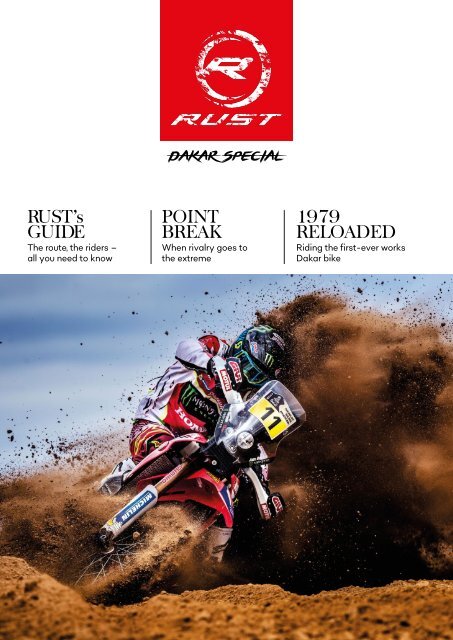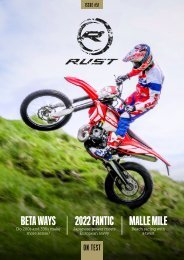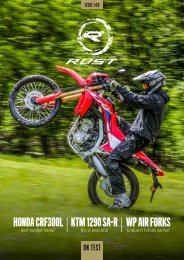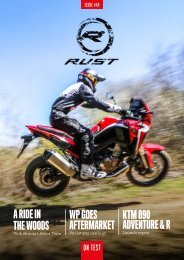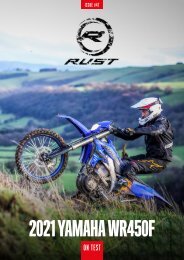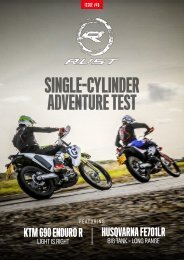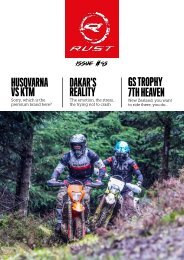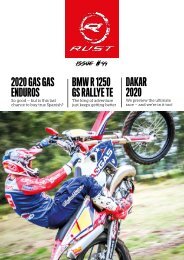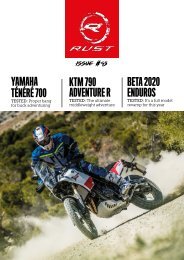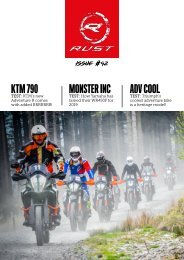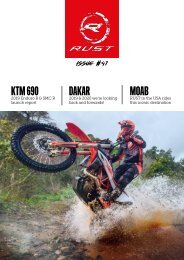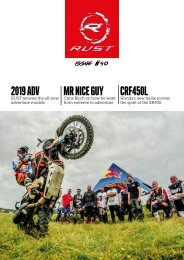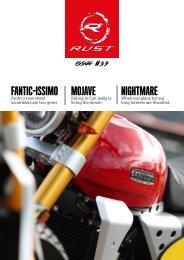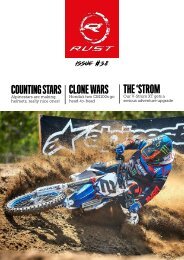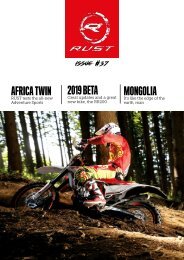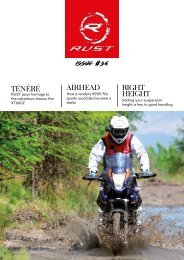RUST magazine: RUST 2018 Dakar Preview
RUST's 2018 DAKAR PREVIEW What’s inside? * THE ROUTE * THE RIDERS * THE HISTORY * PLUS INTERVIEWS & A VERY SPECIAL TEST RIDE Here it is, RUST’s definitive guide to the Dakar Rally 2018. The action starts on January 6 so you’ve got plenty of time to absorb all 80-pages of our guide. Happy riding and reading. And having a Merry Christmas too. See you in the New Year (if not before!) Jon Bentman (Editor, RUST)
RUST's 2018 DAKAR PREVIEW
What’s inside?
* THE ROUTE
* THE RIDERS
* THE HISTORY
* PLUS INTERVIEWS & A VERY SPECIAL TEST RIDE
Here it is, RUST’s definitive guide to the Dakar Rally 2018. The action starts on January 6 so you’ve got plenty of time to absorb all 80-pages of our guide.
Happy riding and reading. And having a Merry Christmas too. See you in the New Year (if not before!)
Jon Bentman
(Editor, RUST)
You also want an ePaper? Increase the reach of your titles
YUMPU automatically turns print PDFs into web optimized ePapers that Google loves.
DAKAR SPECIAL<br />
<strong>RUST</strong>’s<br />
GUIDE<br />
The route, the riders –<br />
all you need to know<br />
POINT<br />
BREAK<br />
When rivalry goes to<br />
the extreme<br />
1979<br />
RELOADED<br />
Riding the first-ever works<br />
<strong>Dakar</strong> bike
C ntents
<strong>RUST</strong> DAKAR PREVIEW<br />
06<br />
Editorial<br />
It’s called The<br />
Great Race<br />
08<br />
Gallery<br />
Mountains and<br />
motorcycle<br />
12<br />
The Route<br />
Two weeks of<br />
moto-hell it<br />
would seem<br />
26<br />
Sam Sunderland<br />
What it takes<br />
to win<br />
www.rustsports.com 3
C ntents<br />
<strong>RUST</strong> DAKAR PREVIEW<br />
36<br />
The Runners<br />
Our pick of the<br />
leading riders<br />
56<br />
XT500<br />
The legend that<br />
launched legends<br />
68<br />
Duel<br />
Neveu vs Auriol<br />
in 1987 – was this<br />
<strong>Dakar</strong>’s toughest<br />
combat?<br />
www.rustsports.com 5
EDITORIAL<br />
6<br />
www.rustsports.com
JB<br />
THE GREAT<br />
RACE<br />
Welcome to our <strong>2018</strong> <strong>Dakar</strong> Special. This 40th edition<br />
of the Rally looks set to be another stunner, with more<br />
riders than ever in contention for the win. The same<br />
goes for the manufacturers. KTM vs. Honda may be<br />
the headlining contest, but both need to keep a very wary eye over<br />
the rest: both Yamaha and Sherco have shown winning capability<br />
and there are more besides.<br />
We’ve decided to turn the clock back twice in this issue, back to 1987<br />
for a classic duel and further still to 1978-79 to when it all began. There<br />
was a romance to those earliest <strong>Dakar</strong>s – more adventure than race – and<br />
being privileged to ride a replica of one of the very first bikes really did<br />
connect me to the feeling back then. Disco fought with punk in the music<br />
charts, Europe was giving way to American invaders in 500GP – these<br />
were not innocent times – but the purity of the endeavour back in ‘79, to<br />
fight your way over 10,000km of deserts for nearly three weeks, that really<br />
was something in that pre-GPS era.<br />
Today’s <strong>Dakar</strong> is more racy, for sure. But the challenge never<br />
diminishes, the organisers see to that. And I love that we can follow the<br />
race in real time (when the <strong>Dakar</strong> website works). We can follow the race<br />
intimately, can track our favourites, and virtually the whole world can<br />
now see the daily film footage (remember at the beginning it was a very<br />
French thing). And <strong>Dakar</strong> really comes alive to the modern digital SLR<br />
camera – the images today can astound, as this special issue will reveal.<br />
It is still The Great Race when it comes to motorsport. And while<br />
professionalism has changed it, while commercial interests and<br />
bullcrap media mean the bivouacs aren’t the wonderfully eclectic<br />
melting pots they once were, it’s still an amazing spectacle. It is<br />
still a very personal thing, too: the riders still make or break<br />
the outcome, not the manufacturers. It makes January a<br />
very special month.<br />
I hope you enjoy reading our guide, and I trust it’ll<br />
enhance your <strong>Dakar</strong> experience.<br />
www.rustsports.com 7
GALLERY<br />
8<br />
www.rustsports.com
THE LONG RIDE<br />
<strong>Dakar</strong> is the big race, it is the long<br />
distances, the long-long-long days. This<br />
fantastic image kind of sums that up. It’s<br />
from the 2017 <strong>Dakar</strong>, and for Pela Renet<br />
the finish isn’t over the mountain in front<br />
of him, probably not the one after that<br />
either. Some days you’ve got to put in<br />
the hours and be patient.<br />
Image: Husqvarna / Marcin Kin<br />
www.rustsports.com 9
GALLERY<br />
10<br />
www.rustsports.com
THE DAKAR BIKE<br />
Have <strong>Dakar</strong> racers come full circle? In<br />
this issue we’ve test ridden a replica of<br />
a 1979 <strong>Dakar</strong> racer, a Yamaha 500cc<br />
single-cylinder four-stroke weighing<br />
about 150-kilos before fuel. After that<br />
first <strong>Dakar</strong> the racers got bigger, much<br />
bigger, until the organisers, trying to<br />
keep a check on safety, forced them to<br />
be smaller again. So this year’s works<br />
Yamaha is a 450cc single-cylinder fourstroke,<br />
weighing about 145kg before<br />
fuel. And the mass-centralising 33-litre<br />
pannier fuel tanks and lightweight<br />
carbon fibre instrument tower mean<br />
today’s rally bikes handle more like an<br />
enduro bike again. There is a beauty to<br />
it, a rugged beauty.<br />
Image: Yamaha<br />
www.rustsports.com 11
SAN<br />
RALLy<br />
12 www.rustsports.com
DAKAR Route<br />
D STORM<br />
THE DAKAR RALLY ROUTE <strong>2018</strong><br />
The 40th <strong>Dakar</strong> Rally looks<br />
set to be a humdinger. Yep, the<br />
toughest race just got tougher…<br />
Words: Georgia Wells<br />
Images: KTM / Husqvarna / Honda / Yamaha / Future7Media<br />
w<br />
www.rustsports.com<br />
13
RALLY<br />
w<br />
January 6, <strong>2018</strong> will mark the start<br />
of the 40th edition of the <strong>Dakar</strong><br />
Rally, and if anything this number<br />
seems lower than expected for a<br />
race with such a rich history and so many<br />
incredible stories. Surprisingly, however,<br />
this race will mark the tenth in South<br />
America. And more than ever, even to the<br />
fans and riders who can remember the<br />
classic Paris-<strong>Dakar</strong> route and the fascinating<br />
and famous stops throughout Africa,<br />
South America really feels like ‘home’ now.<br />
And despite the occasional rumour that<br />
a new continent could be on the cards in<br />
the future, it still feels like there’s plenty to<br />
explore throughout Latin America.<br />
14<br />
www.rustsports.com
<strong>Dakar</strong> Route<br />
w<br />
www.rustsports.com 15
RALLY<br />
w<br />
TO START: PERU<br />
In <strong>2018</strong>, Peru is back on the route after<br />
five years absence. Unpredictable climatic<br />
conditions in the country, and the organisers’<br />
desire to venture into new places, had<br />
left Peru sidelined despite fantastic stages<br />
there in the past, including those alongside<br />
the Nazca lines and Lake Titicaca. This<br />
year, the race will start in Peru’s capital,<br />
Lima, and it’s sure to be one hell of a send<br />
off for the 167 strong biker entry. People in<br />
Peru turn out in their millions to welcome<br />
the <strong>Dakar</strong> circus, and the competitors will<br />
be treated to a vibrant almost carnival<br />
atmosphere, something they’ll need as the<br />
route looks set to be one of the toughest of<br />
recent years.<br />
16<br />
www.rustsports.com
<strong>Dakar</strong> Route<br />
SAND – FIVE DAYS OF HELL?<br />
On the second day of the rally the riders<br />
will immediately be plunged into sand and,<br />
you guessed it, dunes. In fact, for the first<br />
five days of the event the riders will not<br />
only be in the sand, but also on completely<br />
new territory. It’s an incredibly daunting<br />
start to the race and a high attrition rate<br />
can be expected from the outset. On stage<br />
five the riders will also be forced to battle<br />
against one the <strong>Dakar</strong>’s newest phenomena;<br />
high altitude dunes.<br />
w<br />
www.rustsports.com 17
RALLY<br />
w<br />
18<br />
www.rustsports.com
<strong>Dakar</strong> Route<br />
w<br />
www.rustsports.com 19
RALLY<br />
w<br />
20<br />
www.rustsports.com
<strong>Dakar</strong> Route<br />
BOLIVIAN MARATHON<br />
On the sixth day the riders will arrive in<br />
La Paz in beautiful Bolivia, where they will<br />
have their well-deserved rest day. It’s been<br />
a few years since the event has had such a<br />
dramatically difficult start and it is unlikely<br />
we’ll have a clear favourite by the halfway<br />
point as experience and careful riding,<br />
rather than all-out speed or attacking, will<br />
be the approach for the opening five days.<br />
On the plus side, most of the specials in<br />
the opening week of the rally are relatively<br />
short… under 400km! But, just in case<br />
we haven’t lost a third of the field by the<br />
rest day, the organisers have decided to<br />
treat the competitors to a horrendously<br />
challenging marathon for stages seven and<br />
eight. This means zero assistance from<br />
their teams, even for the factory riders, and<br />
a remote (usually quite basic) bivouac.<br />
And how on earth do you make the<br />
marathon even more difficult? Well, you<br />
make the second leg the longest special<br />
on the whole rally! The run from the now<br />
infamous Uyuni to Tupiza will total 498km<br />
of competitive kilometres. The riders could<br />
well struggle to keep their concentration as<br />
high altitudes and exhaustion start to fry<br />
their brains.<br />
w<br />
www.rustsports.com 21
RALLY<br />
w<br />
A HEROES’ RETURN<br />
Those who make it as far as the start of stage<br />
nine will be heroes in their own right. Only<br />
as the rally reaches Argentina for the closing<br />
five stages of the event will the competitors<br />
at last get to wave goodbye to the dunes and<br />
enter more familiar territory. Fast farm tracks,<br />
twisty valley passes, and rocky riverbeds will<br />
make for frightening (high speed) viewing as<br />
the riders attempt to make a final push for<br />
glory. Chuck in another marathon over stages<br />
11 and 12 and they will likely be suffering<br />
both physical and mental pain as Argentina’s<br />
terrain offers zero margin for error, and the<br />
end of the race becomes tantalisingly close.<br />
The penultimate stage provides a proverbial<br />
sting in the tail with a total 904km, and even<br />
the final run to the finish on stage 14 promises<br />
no let up.<br />
A reliable bike, camaraderie among competitors,<br />
and co-operation between teammates<br />
could make a hell of a difference in this race…<br />
22<br />
www.rustsports.com
<strong>Dakar</strong> Route<br />
www.rustsports.com 23
THE DAK<br />
RALLY<br />
w<br />
3<br />
2<br />
40th<br />
edition<br />
countries:<br />
Peru, Bolivia<br />
& Argentina<br />
marathon stages<br />
(back-to-back<br />
stages, no assistance)<br />
24<br />
www.rustsports.com
<strong>Dakar</strong> Route<br />
AR IN NUMBERS<br />
5DAYS<br />
above 3000m<br />
9000km<br />
142 14<br />
stages 4500km<br />
50<br />
quad<br />
competitors<br />
solo competitors<br />
timed specials<br />
www.rustsports.com 25
INSIGHT<br />
Sam Sunderland<br />
WHAT<br />
IT TAKES<br />
TO WIN<br />
2017 <strong>Dakar</strong> winner<br />
Sam Sunderland<br />
explains the challenges,<br />
the pressures and the<br />
sheer relentlessness that<br />
is competing in this, the<br />
biggest rally in the world<br />
Interview: Jon Bentman<br />
Images: Future7Media, KTM, Marcin Kin<br />
w<br />
26
INSIGHT<br />
w<br />
28<br />
www.rustsports.com
SAM SUNDERLAND<br />
<strong>RUST</strong>: IN 2017 YOU GOT YOUR<br />
DAKAR WIN AFTER YEARS OF<br />
TRYING AND NO FINISHES. IT’S<br />
BEEN SAID YOU GOT THAT WIN<br />
BECAUSE YOU WERE A DIFFERENT<br />
RIDER IN 2017.<br />
SS: If you look at the facts, I’ve crashed<br />
out of only one <strong>Dakar</strong>, the others were<br />
mechanical failures or a non-start due<br />
to injury. So while that’s in essence a<br />
one-in-four finishing rate – and while<br />
it’s never good not to finish – three of<br />
them were a little bit out of my hands. In<br />
between I’ve twice finished second in the<br />
world championship – not many people<br />
recognise that – and that’s a five-round<br />
series and each round is a five-day race,<br />
so I got through them all two years in a<br />
row just fine. Yet I’ve definitely had the<br />
image of the crazy young motocross guy<br />
who’s going too fast – often upside down!<br />
But, if I’m honest, maybe I have changed<br />
a bit too, I’ve tried to stay calm and learn<br />
from my mistakes. Obviously going from<br />
winning in Morocco and then breaking my<br />
femur and having to sit at home watching<br />
the 2016 <strong>Dakar</strong> on TV was wrath for the<br />
mind – so yeah, that helped change me in<br />
that sense; I’ve tried to stay a bit more<br />
calm.<br />
<strong>RUST</strong>: HAS IT BEEN A CASE<br />
OF GOING SLOWER TO MAKE<br />
THE FINISH?<br />
SS: I think if you were to go out<br />
there and say to yourself<br />
I’ll ride at a speed where<br />
there’s no chance I’ll<br />
have a crash, then<br />
you’ll be 25 minutes<br />
behind by the end<br />
of the day. The<br />
sport has evolved to<br />
the point where you<br />
are riding so fast that the<br />
risk is there, and it’s a fine line how you<br />
manage that. To go 1% faster you take on<br />
20% more risk so you’re at that kind of<br />
level. I’ve tried to learn from my mistakes,<br />
and you kind of do that naturally when<br />
injuries hurt so bad or when things are<br />
mentally so tough – and I’ve experienced<br />
both of them – so for 2017 I really tried to<br />
stay calm that first week until we reached<br />
the rest day. At the start there are like 10<br />
dudes who could win, but by the rest day<br />
that can be down to four, so that was part<br />
of the plan.<br />
<strong>RUST</strong>: A FEW JOURNALISTS<br />
SEEMED TO IMPLY YOUR<br />
TEAMMATE TOBY PRICE HAD<br />
GONE TOO HARD, TAKEN<br />
TOO MANY RISKS BEFORE HE<br />
CRASHED OUT IN 2017. WAS HE<br />
BEING RECKLESS?<br />
SS: It’s not like that at all, he wasn’t going<br />
off like a firecracker, he wasn’t trying to<br />
show people ‘I’m here, this is what I can<br />
do’. The fact is, in <strong>Dakar</strong> everybody is at<br />
risk at some point, to some extent, and<br />
I think it’s a fine line. In the end Toby<br />
missed seeing one stone and you might<br />
pass 3000 stones in one day. He missed<br />
seeing just one stone in a riverbed<br />
and that was the one that caught him<br />
out. It can happen to any one of<br />
us at any time and I think it’s good<br />
to keep that in mind. It’s easy to<br />
sit-back behind a computer screen<br />
and say ‘he was pushing too<br />
hard’, or ‘he was stressed<br />
because he won the<br />
year before’, in the end<br />
when you’re there<br />
you’re trying to do<br />
your best. Nobody<br />
wants to crash,<br />
nobody wants to get<br />
hurt; it’s a fine line that<br />
you’re treading all day.<br />
w<br />
www.rustsports.com 29
INSIGHT<br />
w<br />
30<br />
www.rustsports.com
SAM SUNDERLAND<br />
<strong>RUST</strong>: HAS DAKAR GOT FASTER<br />
OVER RECENT YEARS?<br />
SS: Yeah, it’s a completely different race<br />
these days. You have so many world<br />
champions from enduro, motocross and<br />
everything else coming into it that the<br />
speed has gone up and up. And it’s all<br />
kinds of younger guys coming in, perhaps<br />
willing to take on more risk. As well, we’re<br />
riding different types of stages now to what<br />
is was then. And with a much greater<br />
depth of talent – not to take anything away<br />
from the top guys of the past, they were<br />
obviously huge talents, but now I think it’s<br />
a lot deeper. There were maybe three guys<br />
who could win in the last ten years, now<br />
I think there are ten guys who could win.<br />
And with that, when there is that many<br />
guys who can win then the level goes up<br />
massively; everyone has to push that bit<br />
extra.<br />
THEY CLAIMED A ‘MORAL<br />
VICTORY’ OVER YOU BASED ON<br />
THEIR RIDERS’ END-OF-RALLY<br />
PERFORMANCE. DID THAT ANGER<br />
YOU?<br />
SS: In a way you have your own thoughts<br />
on it, and I know what the truth is, but at<br />
the same time I appreciate they’re trying to<br />
do a job, working with a massive budget,<br />
and when they have days like that it’s not<br />
good for them and so they have to say<br />
what they say to make themselves feel okay.<br />
For me and for my team, and for a lot<br />
of people, it was clear what the situation<br />
<strong>RUST</strong>: THE 450cc DAKAR BIKE<br />
SEEMS TO HAVE MATURED<br />
– FASTER AND LONG-LASTING…<br />
SS: Its incredible to think what a 450cc<br />
engine can do now: 10,000km over 12 days<br />
in that kind of environment, they are really<br />
strong now. And you don’t manage the<br />
bike at all, unless it’s the last two days and<br />
you have a lead then maybe you start to<br />
be conscious of it. The rest of the time you<br />
ride it as fast as you can go and if its 40<br />
minutes on the limiter in top gear then its<br />
40 minutes on the limiter in top gear, you<br />
don’t back it off a bit to save the engine.<br />
We’re lucky we don’t have to ride like<br />
that any more; the reliability is there and<br />
proven. So it’s more pressure on you – but<br />
it’s a good pressure to have.<br />
<strong>RUST</strong>: HONDA IS ALWAYS KTM’S<br />
FIERCEST RIVAL. AFTER LAST<br />
YEAR’S REFUEL CALAMITY THAT<br />
RESULTED IN BIG TIME PENALTIES<br />
was, and it wasn’t only me who was riding<br />
a different race once they got that time<br />
penalty, everyone was. It doesn’t make<br />
sense to fight for stage wins when there’s<br />
no need. At the Tour de France you don’t<br />
see Chris Froome fighting for the sprints<br />
every day, that’s not how you win the tour,<br />
and it’s the same thing with the <strong>Dakar</strong>.<br />
<strong>RUST</strong>: TALKING OF BIG BUDGETS<br />
AND BIG EXPECTATIONS, WHAT<br />
WAS IT LIKE BEARING THE<br />
PRESSURE OF LEADING THE<br />
DAKAR?<br />
w<br />
www.rustsports.com 31
INSIGHT<br />
w<br />
SS: It was incredible, I knew I was feeling<br />
the pressure and I was trying to manage<br />
it the best I could and when people kept<br />
saying ‘so are you thinking about the win?’<br />
as early as on day ten or 11, I was telling<br />
them ‘no, no I’m not thinking about it at<br />
all’. But come on, of course you are! It’s<br />
something you’ve been working toward<br />
for the past seven years, something you<br />
gone through a bunch of injuries for,<br />
something you’ve worked all year towards,<br />
all the sacrifices – of course that thought<br />
is there. But you try to tell people you’re<br />
not thinking about it to try and convince<br />
yourself. I think you just manage it the<br />
best way you can, but when I crossed the<br />
finish line it was just incredible, it felt really<br />
amazing. So much work, so many ups and<br />
downs finally paying off, it was a relief.<br />
<strong>RUST</strong>: DOES THE PRESSURE BUILD<br />
THE CLOSER YOU GET TO THE<br />
END?<br />
SS: It never lets off, at least. I guess if say<br />
Marc Marquez is going into the last round<br />
of MotoGP and all he has to do is finish in<br />
the top-10 then he can go into that round<br />
knowing he’s done, of course its never done<br />
until its done, but he can just maintain and<br />
take it easy. But the way the navigation<br />
was in the 2017 <strong>Dakar</strong> you could make a<br />
mistake so easily so you could lose your<br />
32<br />
www.rustsports.com
SAM SUNDERLAND<br />
advantage so quickly, so the pressure is<br />
bigger because of that. In <strong>Dakar</strong> you can<br />
never relax – there’s no ‘its done unless<br />
I have a mechanical’, no ‘it’s done unless<br />
something freaky happens’. It’s never done<br />
until you cross that line, it’s too easy to<br />
make a mistake. That makes it harder.<br />
<strong>RUST</strong>: SO WAS IT A MONKEY OFF<br />
YOUR BACK? COULD YOU ENJOY<br />
THE SENSE OF ACHIEVEMENT?<br />
SS: When people say as a works rider you’re<br />
living the dream… well, you are but it’s not<br />
how people think it is. It’s a lot of work, a lot<br />
of commitment, a lot of people relying on<br />
you, putting faith into your riding and your<br />
work. You definitely feel the expectation and<br />
pressure – all the time. The pressure never<br />
leaves – first you want to win a stage, then<br />
you want to win a rally, then when you win<br />
that rally you go to the next and what do<br />
you know? You’re expected to win again.<br />
So that expectation is always there and it<br />
grows with each win. And now I’ve won the<br />
biggest rally there is, next time there’ll be<br />
the expectation to do it again. That work,<br />
that expectation, never ends, it never goes<br />
away, it just gets more. But for as long as I<br />
want to win more than I feel the pressure<br />
then I don’t mind. Right now I want to win<br />
more than I feel the pressure of someone<br />
telling me I need to win.<br />
www.rustsports.com 33
INSIGHT<br />
w<br />
34<br />
www.rustsports.com
SAM SUNDERLAND<br />
IN DAKAR YOU CAN<br />
NEVER RELAX –<br />
IT’S NEVER DONE<br />
UNTIL YOU CROSS<br />
THAT LINE<br />
Sam Sunderland<br />
www.rustsports.com 35
Rally<br />
36 www.rustsports.com
DAKAR Racers<br />
Words: Georgia Wells<br />
Images: KTM / Husqvarna / Honda / Yamaha / Future7Media<br />
THE DAKAR RALLY <strong>2018</strong><br />
THE RACERS<br />
The <strong>Dakar</strong> again looks wide open. It’s anyone’s game, or is it? w<br />
www.rustsports.com<br />
37
Rally<br />
w<br />
RED BULL<br />
KTM Factory Racing<br />
Having won the <strong>Dakar</strong> Rally for the<br />
last 16 years, Red Bull KTM Factory<br />
Racing obviously come into the<br />
<strong>2018</strong> race as favourites. However, it<br />
hasn’t been plain sailing for the Austrian<br />
squad as two of their five riders have been<br />
injured and have fought to be fully fit for<br />
this year’s race.<br />
After a brilliant win in 2016, Toby Price<br />
checked out of the 2017 <strong>Dakar</strong> early, crashing<br />
heavily on the fourth stage and badly breaking<br />
his thigh. But the tough Aussie is fully healed<br />
up now and ready to attack to the max (which<br />
seems to be his style) once again. KTM’s home<br />
boy (Austrian), Matthias Walkner will be hoping<br />
to go head-to-head with Price; he finished<br />
second last year and celebrates a deal signed<br />
earlier this year which sees him stay with<br />
KTM until 2020. Perhaps the most dependable<br />
member of the team is actually Laia Sanz<br />
– while the ‘Queen of Off-Road Racing’ is<br />
unlikely to win the race, she is incredibly consistent,<br />
having finished all of the seven <strong>Dakar</strong>s<br />
she has started. Sanz has won the Women’s<br />
class four times in a row and finished in the top<br />
16 overall three times, including three topeight<br />
stage finishes. Laia says her aim is the top<br />
15 again in <strong>2018</strong>, but one of these years the<br />
Catalan superstar is going to spring a surprise<br />
and find herself well within the Top 10.<br />
38<br />
www.rustsports.com
DAKAR Racers<br />
Sam Sunderland<br />
w<br />
www.rustsports.com 39
Rally<br />
w<br />
Completing KTM’s incredibly strong<br />
line-up are Sam Sunderland and Antoine<br />
Meo. Sunderland’s exhilarating win last<br />
January, when he became the first Brit to<br />
win the <strong>Dakar</strong>, brought a lot of attention to<br />
the sport as a whole but also put the spotlight<br />
on Sam after several years of bad luck<br />
and disappointing results. The likeable lad,<br />
who originally hails from Poole in the UK<br />
but now lives in the deserts of Dubai, will<br />
be hoping to prove that his emphatic win<br />
last year was no fluke, and the thousands<br />
of fans who have followed his spectacular<br />
social media photos throughout the year<br />
will be backing him all the way.<br />
Meo has not had an easy run of things<br />
since his <strong>Dakar</strong> debut in 2016, where he<br />
finished an excellent seventh place. The<br />
Frenchman suffered a huge crash just days<br />
before the end of the rally, but he gritted<br />
his teeth to cross the finish line. It became<br />
clear afterwards that the injuries to his<br />
hands were far worse than anyone realised<br />
– in fact they would keep him out of<br />
Antoine Meo<br />
Matthias Walkner<br />
40<br />
www.rustsports.com
DAKAR Racers<br />
action for over a year and he missed the<br />
2017 <strong>Dakar</strong>. There was doubt over whether<br />
he would come back, the psychological<br />
damage clearly having an impact on the<br />
five-time world enduro champion. But<br />
finally, Meo has been able to silence the<br />
doubters with an excellent fourth place in<br />
the Rallye Du Maroc in October this year.<br />
Meo is back and ready to race, and as any<br />
enduro fan will tell you, an on-form Meo<br />
is a dangerous one. With riders like these,<br />
KTM seem almost guaranteed a 17th win!<br />
BELOW: Laia Sanz &<br />
Luciano Benavides<br />
Toby Price<br />
w<br />
www.rustsports.com 41
Rally<br />
w<br />
Andrew Short<br />
42<br />
www.rustsports.com
DAKAR Racers<br />
ROCKSTAR<br />
Energy<br />
Husqvarna<br />
Sibling team Rockstar Energy<br />
Husqvarna are often strong contenders<br />
to go head-to-head with the<br />
orange squad but for <strong>2018</strong> things<br />
will be a little different with only half of<br />
their regular team able to take to the start<br />
line on January 6. Pierre-Alexandre Renet,<br />
left a successful enduro career a couple<br />
of years ago, determined to become a top<br />
level rally rider. But during his <strong>Dakar</strong><br />
debut in 2016 he knocked himself out cold,<br />
leaving Laia Sanz (the first rider to find<br />
him) shocked and fearing the worst. A year<br />
later ‘Pela’ made good, finishing a superb<br />
seventh. He was finally ready to attack the<br />
<strong>Dakar</strong>, but disaster has struck once again<br />
for the talented Frenchman; during the<br />
Atacama Rally in August of this year Pela<br />
hit a hidden pothole at 150km/h. He was<br />
catapulted through the air and woke up<br />
two days later in hospital in Santiago, having<br />
been placed in an artificial coma.<br />
“I’m used to hospitals,” he declared,<br />
stoically. But his injuries were serious. Pela<br />
had fractured a few cervical vertebrae,<br />
and needed 20 screws to put his arm back<br />
together. “It may sound strange but I am<br />
fortunate in my bad luck… this situation<br />
is bad but not as bad as it could be, my helmet<br />
was completely destroyed and it was a<br />
fast crash.”<br />
w<br />
www.rustsports.com 43
Rally<br />
w<br />
Sadly for the Frenchman, and for the sport<br />
in general, these injuries were too serious<br />
for him to recover in time for the <strong>2018</strong><br />
<strong>Dakar</strong>. And so Husqvarna have drafted in<br />
American rookie Andrew Short, yes the<br />
former AMA supercross star, as his replacement.<br />
This is Short’s first year in rally, and<br />
he’s publicly stated he’ll play himself in<br />
carefully.<br />
So for Husky, all eyes – and hopes – will<br />
be on Pablo Quintanilla. The South American<br />
star came very close to toppling Sam<br />
Sunderland last year before he was forced<br />
to retire with dizziness. And he has backto-back<br />
FIM Rallies Championship titles<br />
(2016 & 2017). Many people have picked<br />
Pablo as a favourite for the last few years,<br />
but sadly the likeable Chilean will not be<br />
able to enjoy the exaltation of victory on<br />
home turf as Chile’s stunning stages are<br />
sidelined for yet another year. Although the<br />
team are obviously hurting to be starting<br />
without Pela, it could actually play to their<br />
advantage having just one top rider to focus<br />
on in Quintanilla, and having a stand-in<br />
team-mate who ought to be happy to play<br />
the ‘water carrier’ role could help, too.<br />
Pablo Quintanilla<br />
44<br />
www.rustsports.com
DAKAR Racers<br />
w<br />
www.rustsports.com 45
Rally<br />
w<br />
46<br />
www.rustsports.com
DAKAR Racers<br />
MONSTER<br />
Energy Honda<br />
As was ever the case, <strong>Dakar</strong> <strong>2018</strong> will see<br />
the continuation of Japan’s quest for gold.<br />
The last time Honda won was way back in<br />
1989 (Gilles Lalay on the NXR800!) and<br />
year-on-year they seem to come out with a stronger,<br />
more reliable bike and a stronger line-up.<br />
w<br />
www.rustsports.com 47
Rally<br />
w<br />
For the 40th <strong>Dakar</strong>, HRC have thrown<br />
as many ‘big guns’ as possible towards the<br />
startline – in stark contrast to Husqvarna’s<br />
tiny team. Honda have a couple of proven<br />
riders such as the ever-reliable Paulo<br />
‘Speedy’ Gonçalves and Joan ‘Bang Bang’<br />
Barreda. And three ‘improving’ or upand-coming<br />
riders in the form of Michael<br />
Metge, Ricky Brabec and Argentina’s dark<br />
horse Kevin Benavides.<br />
All five riders are capable of top 10-<br />
15 finishes and Barreda, Benavides and<br />
Gonçalves have the pace to win. But while<br />
so many people across the world would<br />
love to see Paulo win after so many years<br />
of heroics and self-sacrifice, or Joan win<br />
due to his spectacular riding style and wild<br />
antics, or Kevin win as an enduro-to-rally<br />
convert who would be close to home for<br />
Cordoba’s frenetic closing ceremony, it<br />
seems hard to imagine after so many years<br />
of orange domination.<br />
Paulo Gonçalves<br />
Ricky Brabec<br />
48<br />
www.rustsports.com
DAKAR Racers<br />
Kevin Benavides<br />
Michael Metge<br />
w<br />
www.rustsports.com 49
Rally<br />
w<br />
50<br />
www.rustsports.com
DAKAR Racers<br />
YAMALUBE Yamaha<br />
Over in the blue corner, Yamaha will be<br />
aiming for their first victory since 1998<br />
with a deceptively strong line-up of Franco<br />
Caimi, Xavier de Soultrait, Rodney<br />
Faggotter, and of course, Adrien Van Beveren.<br />
w<br />
www.rustsports.com 51
Rally<br />
w<br />
The French sand specialist Van Beveren<br />
will be very much the leading light for the<br />
team, especially as this year’s route contains<br />
so many sand stages, but Caimi and<br />
de Soultrait will also be hoping to push the<br />
top 10. As the race draws on they, along<br />
with Faggotter, may be asked to make<br />
sacrifices in order to allow a spectacularly<br />
quick Van Beveren to build on his fourth<br />
place of last year.<br />
Franco Caimi<br />
Xavier de Soultrait<br />
52<br />
www.rustsports.com
DAKAR Racers<br />
Rodney Faggotter<br />
Adrien<br />
Van Beveren<br />
w<br />
www.rustsports.com 53
Rally<br />
DAKAR Racers<br />
w<br />
Lyndon<br />
Poskitt<br />
THE OTHERS<br />
But even if KTM do take the top spot once<br />
again, there’s no guarantee it’ll be a factory<br />
rider at the helm. The Spanish run Himoinsa<br />
KTM team are extremely professional<br />
and possess some excellent riders for<br />
<strong>2018</strong>. Ivan Cervantes and Gerard Farres<br />
are podium contenders at the very least<br />
and Marc Sola and Dani Oliveras will aim<br />
to stick in behind their competitive compatriots.<br />
Rosa Romero and Antonio Ramos<br />
will represent the squad from lower down<br />
the field, ready to help if needs be, or in<br />
Rosa’s case, ready to do battle with Laia<br />
Sanz for the Women’s crown.<br />
There are also a number of excellent<br />
former enduro riders who could throw in<br />
some surprises; such as Alessandro Botturi,<br />
Stefan Svitko, Jacopo Cerutti and Olivier<br />
Pain to name but a few. And those riding<br />
for ‘newer’ <strong>Dakar</strong> brands such as Juan<br />
Pedrero on Sherco, Johnny Aubert and<br />
Jonathan Barragan on Gas Gas, and Oriol<br />
Mena and Joaquim Rodrigues on Hero (an<br />
Indo-German offshoot of Speedbrain). It’s<br />
all to play for!<br />
MALLE MOTO<br />
Of course there are also those who will<br />
be heading to the <strong>Dakar</strong> with no hope of<br />
winning the ‘main’ class, but who re-mortgage<br />
their houses and stop at nothing short<br />
of selling a kidney to afford the entry fee,<br />
just to be there and experience it. There<br />
are those who will pitch up with just a bike<br />
and box to take on the unbelievably tough,<br />
zero-assistance, Malle Moto class. One of<br />
these heroic riders is Lyndon Poskitt, a Brit<br />
who has made a name for himself via an<br />
online documentary series named ‘Races<br />
to Places’. For <strong>2018</strong> Poskitt will be filming<br />
every aspect of life as a Malle Moto rider,<br />
and we at <strong>RUST</strong> urge you to follow him<br />
and his competitors as they take on this<br />
mammoth task – it will give you a whole<br />
different take on what it’s really like to race<br />
the <strong>Dakar</strong>.<br />
Perhaps more than ever, this year’s route<br />
will challenge even the fastest and most<br />
experienced riders, from the new dunes<br />
ready to catch them out at the beginning,<br />
to coping with the marathon stages, to<br />
keeping calm on the pacey run into the<br />
finish. The eventual winner will need to be<br />
truly multi-faceted, as well as fortunate, in<br />
order to tame the <strong>2018</strong> edition of this incredible<br />
race! And even as mere fans of this<br />
legendary event, which you can love one<br />
moment and hate the next, we are in for a<br />
rollercoaster of a ride. Hold on tight!<br />
54<br />
www.rustsports.com
IT’S MAKING YOUR<br />
OWN ADVENTURE<br />
We understand the excitement of looking for that<br />
next adventure; planning, researching and booking<br />
your latest trip. If it’s a brand new destination or a<br />
well-travelled route, when it comes to insuring your<br />
bike, we go the extra mile for our riders, meaning<br />
you can follow the tracks and enjoy your adventure.<br />
• We search our panel of insurers to find you<br />
our best price for the cover you need<br />
• 90-day EU cover as standard<br />
• Expert 24-hour claims service<br />
• Get discounts on kit, gear, travel and bike<br />
experiences with Bennetts Rewards*<br />
#ItsWhatWeDo<br />
Visit Bennetts.co.uk<br />
or call 0330 018 5943 for a quote<br />
*All offers subject to Terms & Conditions. Offer subject to change.
heritage<br />
WHERE IT ALL STARTED<br />
The <strong>Dakar</strong> Rally is celebrating its 40th edition in <strong>2018</strong>. So we’ve rolled back<br />
the years to the very first, to see where – and on what – it all began<br />
words: Jon Bentman images: Stuart Collins<br />
Back in the late 1970s the desert<br />
rallying scene was in its infancy,<br />
and it was then a very French<br />
thing. For the French it was a<br />
very natural adventurous step to cross<br />
the Mediterranean and venture into<br />
their (former) African colonies.<br />
They’d been doing it for decades,<br />
informally. But in the late 1970s the<br />
concept of the adventurous race really<br />
came alive. The idea of a 10,000km stagerace<br />
across the deserts of Northern Africa<br />
certainly caught the French imagination.<br />
That rallying was still an adventure,<br />
more than a race, can be seen by the<br />
hotch-potch entry for that first <strong>Dakar</strong> Rally<br />
back in 1979 (nearly entirely privateers),<br />
which included a fair range of romantics<br />
peppered among the racers, including<br />
a chain-smoking journalist on a BMW<br />
R65 complete with screen and panniers,<br />
another hopeful on nothing more than a<br />
Honda XL125S, not to mention the usual<br />
array of humble Renault 4 and Peugeot<br />
504 runabouts in the car class – there was<br />
even a Ford Transit.<br />
The first winner, overall and moto class,<br />
was a 23-year-old Frenchman, a former<br />
French trials champion, Cyril Neveu. He<br />
later spoke of that first <strong>Dakar</strong> not in terms<br />
of the competition but the adventure:<br />
“It was more a human adventure than<br />
anything else. It was a challenge that<br />
was to discover Africa first of all, by the<br />
motorcycle, and by means of competition.<br />
“So there were several challenges at<br />
the end, the discovery of a continent that<br />
I did not know, that fascinated me and<br />
after that the challenge of a victory since I<br />
came from a sporting environment.”<br />
That’s not to say the very first <strong>Dakar</strong><br />
rally wasn’t competitive. At the front of<br />
the pack was the very first works rally<br />
team, Sonauto Yamaha, who bought an<br />
array of fast racers, some from motocross,<br />
some from trials. They were all riding<br />
Yamaha’s popular trail bike of the day,<br />
the XT500.<br />
56<br />
www.rustsports.com
YAMAHA XT500<br />
w<br />
www.rustsports.com 57
heritage<br />
w<br />
DAKAR’S ONLY PRIVATEER WIN<br />
The team, led by Yamaha boss Jean Claude<br />
Olivier was expected to win. But their tactics<br />
were their undoing. They rode fast and they<br />
rode together. When one made a navigational<br />
error, they all did and this happened as early<br />
as the third stage, when they lost five hours<br />
on the stage and lost a further seven hours in<br />
penalties. Subsequent fast riding did nothing to<br />
pull back their disadvantage, instead it ended<br />
in big crashes that sidelined two of their top<br />
riders, Olivier and Rudy Positek. Eventually,<br />
teammate Gilles Comte placed a Sonauto XT<br />
on the second step of the podium in <strong>Dakar</strong> –<br />
by means of steady work. He’d punctured and<br />
lost much time on the very first stage and so<br />
hadn’t ridden with the fast-n-furious Sonauto<br />
pack. He didn’t ascribe to the speed tactic, like<br />
Neveu for him it was technical skills and longhaul<br />
strategy that worked.<br />
Neveu won without taking a single stage<br />
victory, instead using technical ability and a<br />
long-game approach. And with the constant<br />
and valuable assistance of his father who could<br />
be reliably found at every bivouac, he had<br />
excellent support. And no doubt Papa Neveu<br />
was very useful when it came to an engine<br />
swap after the eighth stage.<br />
1979 was the first and last time the <strong>Dakar</strong><br />
was one by a private entrant. By 1980 Neveu<br />
(who would win five <strong>Dakar</strong>s in all) would be<br />
factory-supported and he’s thanked his good<br />
fortune that happened as in his words ‘it<br />
allowed me to make my passion my job’. But<br />
the rally for Neveu has always been more than<br />
just a race:<br />
‘For me, it is a fantastic life experience. I<br />
have not studied extensively, so it is a fantastic<br />
school of life. A school of humility because<br />
when one is alone in the desert with his<br />
motorcycle, one must know how to control the<br />
elements, manage oneself or even manage a<br />
team also because when one is part of a team,<br />
one has ‘accounts’. But it was only fun. And<br />
when you have the chance to live for thirty<br />
years your passion, it’s great.’<br />
58<br />
www.rustsports.com
YAMAHA XT500<br />
w<br />
www.rustsports.com 59
heritage<br />
w<br />
60<br />
www.rustsports.com
YAMAHA XT500<br />
THE 1979 YAMAHA XT500<br />
In the early 1970s there were no rally bikes, no<br />
adventure bikes. The Americans had enduros<br />
and desert racers. The Europeans simply had<br />
trail bikes. The XT500 accordingly responded<br />
to American demand, where dirt biking was<br />
booming and riders who’d enjoyed Yamaha’s<br />
cool reliable two-stroke DT trail bikes were<br />
wanting for something bigger. The XT was<br />
only Yamaha’s second four-stroke.<br />
Shiro Nakamura, leader of the XT engine<br />
project remembers: “When the off-road<br />
market started booming in the US, bikers<br />
remembered the advantages of the good old<br />
singles. Soon the sales guys started to request<br />
the development of a four-stroke for off-road.<br />
Honestly speaking, we engineers were quite<br />
reluctant in the beginning, since we knew<br />
about the difficulties of these big thumpers. As<br />
soon as they had a bit more power they turned<br />
out to be unreliable and they were shaking like<br />
hell.<br />
“I can confess that developing this first big<br />
single was a real nightmare. We tested many<br />
different configurations including DOHC<br />
and even cylinder head oil cooling, but the<br />
XT was supposed to be simple and reliable<br />
and eventually we turned away from all these<br />
complicated solutions.<br />
“In the end all our technical problems delayed<br />
the roll out by more than one year. But we had<br />
succeeded, the XT was now more reliable than<br />
a big single four-stroke had ever been! Although<br />
it was over-square with a bore and stroke of 87<br />
x 84mm, (all British bikes were long stroke), we<br />
obtained the real character of a big thumper.<br />
The two-valve head gave a flat torque curve<br />
while the smaller flywheel allowed the engine<br />
to rev up as easily as we wanted. Dry sump<br />
and short stroke also allowed for better ground<br />
clearance and a more compact engine than<br />
former British bikes ever had.”<br />
The XT produced 32hp, in a package<br />
that weight 149kg (not light!), although it<br />
was simple in design. And Yamaha gave it<br />
traditional 21/18” wheels while the suspension<br />
was of the longer-travel type that was<br />
emerging. The competition-biased TT version<br />
was a hit in the US while the XT went big in<br />
Europe, especially in France, selling a reported<br />
62,000 units there over its five-year lifespan.<br />
The bike was then ideally placed when<br />
the rally phenomenon took off. As well, with<br />
Yamaha having a well developed motocross<br />
range, with components that could crossover<br />
to the XT, it was possible to create a<br />
competitive rally with parts straight off the<br />
parts shelf.<br />
w<br />
www.rustsports.com 61
heritage<br />
w<br />
NOT THE WINNING BIKE!?<br />
It’s a curious thing. Yamaha won the first<br />
ever <strong>Dakar</strong> Rally (then the Paris-Alger-<br />
<strong>Dakar</strong> Rally) with the XT. Only the bike<br />
that was feted in the official posters of<br />
the day was not the winning bike, but<br />
the machine that finished eighth (fifth<br />
moto home), as ridden by French multichampion<br />
trials rider Christian Rayer.<br />
Perhaps the French Yamaha importer,<br />
Sonauto, who’d entered a high-profile<br />
team in the race with full expectation<br />
of victory, couldn’t bring themselves to<br />
publicise the success of what was a<br />
privateer, dealer-backed entry (Neveu)<br />
– especially given the green/white paint<br />
on that bike said Kawasaki more than it<br />
said Yamaha. Perhaps it was that Rayer’s<br />
bike was the cleanest machine out of the<br />
container on return from the rally? Still an<br />
odd choice, given a Sonauto rider, Gilles<br />
62<br />
www.rustsports.com
YAMAHA XT500<br />
Comte, placed runner-up. For now we don’t<br />
have the answers, but for sure the bike<br />
that led the poster campaign in 1979 was<br />
one bearing Rayer’s number – and clearly<br />
even then it was cleaned-up post rally,<br />
with a different number board and change<br />
of shocks – and so its that bike that our<br />
XT enthusiast Mark Smith has replicated<br />
here, given it was the bike with the highest<br />
profile and best photo documentation…<br />
www.rustsports.com 63
heritage<br />
w<br />
RIDING THE SONAUTO YAMAHA XT500<br />
(REPLICA)<br />
This isn’t Christian Thayer’s Sonauto Yamaha<br />
XT500 from the 1979 <strong>Dakar</strong>. But it’s so<br />
close to the original even Thayer himself was<br />
apparently close to believing it was the real<br />
thing. It’s been painstakingly researched and<br />
built by an XT500 enthusiast based in the<br />
UK’s Lincolnshire. Mark Smith has restored<br />
countless XT’s before this, but fancied a bigger<br />
challenge. And it was a bigger challenge, for<br />
as Smith explained, he had little more than<br />
photos and the odd French <strong>Dakar</strong>-fan website<br />
to reference. As a consequence so many of<br />
the parts were recreated from scratch, simply<br />
scaling from old photos.<br />
Some aspects of the original bike’s build he<br />
could trace fairly accurately, like the use of the<br />
YZ400 forks and rear wheel. Other things,<br />
like the unique rear brake arrangement, he<br />
had to work out for himself, probably, Smith<br />
says, much like the Sonauto mechanic did<br />
back in the day – cut this, weld that. And as<br />
these were the early days of rally, the suppliers<br />
back then weren’t the specialist suppliers you’ll<br />
encounter today. So that original super-padded<br />
<strong>Dakar</strong> seat, it was made by a French slipper<br />
manufacturer (Smith: ‘actually my seat isn’t<br />
the same, the original was leather on top and<br />
plastic on the sides, it looked ghastly, so I’ve<br />
used suede on mine!’) And some things you<br />
simply can’t source today, like the rear shocks.<br />
Smith thinks the <strong>Dakar</strong> bikes ran 400mm units<br />
(Konis in later years), but he can’t find similar<br />
today, so the 360mm units he has are the<br />
nearest he could find.<br />
It is though a triumph. The attention to<br />
detail means, save for those shocks, everything<br />
is ultra-close to the original, right down to the<br />
handmade racks to support the tool bags on<br />
the back mudguard (a period Preston Petty, of<br />
64<br />
www.rustsports.com
YAMAHA XT500<br />
course). It really is a time warp experience.<br />
The simplicity of the XT, the robustness,<br />
puts you more in mind of a WWII bomber<br />
than a modern day rally racer. It speaks of the<br />
end of the analogue era. And yet the XT feels<br />
surprisingly muscular. It felt like that back in<br />
1976, too. Some 32hp was pretty lusty for a<br />
500cc single back then. But I’m surprised it<br />
still feels so punchy today, when we’re used<br />
to seeing nearly 60hp from a 500. The XT<br />
should feel ‘pony’, but it doesn’t.<br />
You can attribute that to the fact that the<br />
32hp is at least well-concentrated, for that<br />
power all comes in the first 6000rpm, or<br />
thereabouts. Modern 500s will rev to around<br />
9000rpm, and more, to unleash their full<br />
potential, so there’s a sense of the power curve<br />
being stretched out. With the XT it comes in<br />
early and with meaning. Okay, it’s not quite<br />
arm stretching, but certainly enough to make<br />
your butt sink back into the soft foam of the<br />
luxuriant saddle as you wind on the throttle<br />
– and with a slight tug on the handlebars that<br />
makes for easy, almost slow-motion, wheelies.<br />
And while 32hp doesn’t sound much, there’s<br />
a feeling that this much does at least exceed<br />
the capability of the chassis, for ridden offroad<br />
that comparatively basic spec suspension<br />
soon feels to be both bottoming and topping<br />
out – suspension tech still had a long road<br />
(track) ahead back in 1979.<br />
Yet the XT is hugely enjoyable. It needs a<br />
kick to start, by the way. There are tales of<br />
legend about kick-starting XTs, but with this<br />
example it couldn’t be easier. Just gently turn<br />
the engine over on the kick start until the<br />
compression stops the process, then pull in the<br />
compression release lever and with a gentle<br />
push on the kick start gently push the engine<br />
just over top dead centre, then release the lever<br />
and give the kick start (from the top of its arc)<br />
a firm swing, on zero throttle. The XT fired<br />
w<br />
www.rustsports.com 65
heritage<br />
w<br />
first time every time. Maybe those old XTs<br />
just needed a good fettle; with a clean set<br />
of points and a well setup carb it’s no issue.<br />
Or maybe we just got lucky.<br />
There’s a five-speed gearbox in the XT,<br />
which shifts surprisingly sweetly, up and<br />
down, and given the low rev excellence<br />
you’re not fishing for a sixth ratio. This XT<br />
had slightly longer gearing, ideal for desert<br />
racing, so it would cruise at 50mph with<br />
just a gentle throb from the motor.<br />
We just loved the <strong>Dakar</strong> modifications,<br />
they make the XT even more special, and<br />
although this is a replica, it’s so faithful to<br />
the original (these are the correct 400MX<br />
forks, it is a TT-spec exhaust, every detail<br />
has been meticulously recreated) that the<br />
performance feels utterly authentic.<br />
The XT rides high on the <strong>Dakar</strong><br />
suspension set-up and the special seat<br />
adds further to the height, so you ride at<br />
a similar height to a modern bike, it’s not<br />
arse-dragging low. And while us modern<br />
day riders struggle to adapt to the seated<br />
riding position – the generously swept-back<br />
handlebars ensure you do stay seated (to<br />
stand when riding was clearly considered<br />
no more than an emergency procedure<br />
back then) – to be seated feels surprisingly<br />
natural on the XT. Besides the tank is so<br />
wide at the back (let alone at the front!)<br />
that standing requires a slightly bow-legged<br />
gait. Sitting is the correct modus.<br />
In all it was a privilege to ride this bike,<br />
for just a short while to experience a little<br />
of what the Sonatuo Yamaha riders,<br />
and indeed Cyril Neveu, enjoyed in that<br />
first <strong>Dakar</strong> in 1979. For sure, inside of<br />
a decade, desert race bike development<br />
would bring sophisticated machines that<br />
make the XT look like a kiddy plaything,<br />
but that still can’t diminish what a<br />
superb bike the <strong>Dakar</strong> XT was, nor its<br />
significance. Some 38 of the 90 bike entries<br />
in that first <strong>Dakar</strong> were XT500s. And for<br />
a while there the XT was to rally what<br />
Yamaha’s TZ was to grand prix road<br />
racing. Respect is due.<br />
66<br />
www.rustsports.com
YAMAHA XT500<br />
IN ALL IT WAS<br />
A PRIVILEGE TO<br />
RIDE THIS BIKE,<br />
TO EXPERIENCE A<br />
LITTLE OF WHAT<br />
THE YAMAHA<br />
RIDERS ENJOYED<br />
IN THAT FIRST<br />
DAKAR<br />
www.rustsports.com 67
DAKAR<br />
Lorem ipsum dolor sit amet,<br />
consectetur adipiscing elit.<br />
Fusce volutpat sit amet<br />
justo id sodales. Nullam<br />
auctor sem sit amet nunc<br />
maximus tincidunt. Phasellus<br />
eget vestibulum tortor,<br />
et tincidunt massa. Curabitur<br />
convallis purus dui, ac porta quam sodales<br />
sit amet. Pellentesque fringilla ipsum augue,<br />
eget scelerisque sapien efficitur quis. Vestibulum<br />
aliquet mi et aliquet porttitor. Nulla facilisi.<br />
Phasellus eget luctus dui. Maecenas consectetur<br />
aliquet ultricies. Morbi iaculis orci ex, eget<br />
molestie ligula imperdiet mollis. Cras cursus<br />
purus vitae velit auctor, a fermentum ante<br />
commodo. Curabitur imperdiet ligula id dolor<br />
cursus tempor. Integer suscipit elementum ligula,<br />
sit amet congue felis faucibus sed. Phasellus<br />
imperdiet, lorem eu dignissim congue, felis<br />
dolor pretium turpis, sed ornare diam ante<br />
quis lectus. Fusce sollicitudin convallis urna vel<br />
accumsan. Donec lectus tortor, cursus sit amet<br />
risus eget, bibendum sodales purus.<br />
TOM GETS VERY EXCITED<br />
Praesent urna enim, dapibus a dapibus vel,<br />
condimentum quis ipsum. Donec aliquam massa<br />
sed odio suscipit, sagittis scelerisque urna<br />
dapibus. Duis iaculis ex vel elit ullamcorper, ac<br />
malesuada mauris tincidunt. Sed at mi ipsum.<br />
Suspendisse luctus hendrerit lobortis. Duis nisi<br />
ante, gravida ut dui quis, pellentesque maximus<br />
ex. Phasellus tristique, est eu lobortis scelerisque,<br />
dui quam euismod leo, in dignissim turpis<br />
nulla in ex. Duis vulputate ultricies sagittis.<br />
Integer aliquam tortor a tellus sollicitudin, rutrum<br />
vestibulum arcu aliquam. Nam imperdiet,<br />
est eu fringilla porttitor, arcu metus sagittis est,<br />
quis semper dui massa sed arcu. Integer at metus<br />
purus. Vestibulum efficitur pretium lorem<br />
at vulputate. Donec et fermentum nibh. Morbi<br />
sit amet eros mi.<br />
68<br />
www.rustsports.com
Neveu and Auriol<br />
DUEL<br />
The <strong>Dakar</strong> has created many rivalries over the years, but few battles can<br />
match that between Frenchmen Cyril Neveu and Hubert Auriol in 1987<br />
Words: Chris Evans<br />
To be a hero you need two essential ingredients:<br />
the opportunity to be heroic, and lots of<br />
witnesses (the more the merrier). With the whole<br />
of France in the grip of Paris-<strong>Dakar</strong> fever and<br />
two very different Frenchmen fighting it out<br />
for victory, the 1987 <strong>Dakar</strong> Rally was all set for Hubert<br />
Auriol and Cyril Neveu to achieve super-hero status.<br />
The final curtain was even more dramatic than either of<br />
them could ever have imaged…<br />
w<br />
www.rustsports.com 69
DAKAR<br />
w<br />
70<br />
www.rustsports.com
Neveu and Auriol<br />
SHOULDER PADS AND SUITCASES…<br />
There’s no denying that the <strong>Dakar</strong> gets the<br />
sort of media coverage that other off-road<br />
events can only dream about. This year<br />
it was broadcast in almost 190 countries,<br />
with 70 channels putting out a staggering<br />
1200 hours of programme time. While<br />
globally the race’s popularity increases<br />
year on year, paradoxically in France, from<br />
where it is organised, it no longer enjoys<br />
the almost saturation coverage it attracted<br />
in the politically incorrect 1980s. Back<br />
then, in the era of big shoulder pads and<br />
suitcase sized mobile phones, the Paris<br />
<strong>Dakar</strong> was a media monster. The two<br />
big glossy weekly mags Paris Match and<br />
VSD were main sponsors, as was the radio<br />
station Europe 1 and national TV. Across<br />
the country families who had absolutely<br />
no interest in motorsport sat down nightly<br />
to watch their heroes battle it out on the<br />
pistes of Africa. It was like the Tour de<br />
France and Wimbledon all rolled into one.<br />
Its almost instant success had a lot to<br />
do with the visionary genius behind it,<br />
Thierry Sabine, who was also the brains<br />
behind the most spectated off-road event<br />
in the world, the Enduro du Touquet. He<br />
actually pinched the rally-raid idea off a<br />
bloke called Claude Bertrand, who organised<br />
a race called the Abidjan-Nice. Sabine<br />
signed up to the second Abidjan-Nice at<br />
the tender age of 27 and while lost in the<br />
Sahara for three days vowed that if he survived<br />
he would organise something even<br />
more insane. The Paris-<strong>Dakar</strong> was born.<br />
w<br />
www.rustsports.com 71
DAKAR<br />
w<br />
AN IRRESPONSIBLE DREAMER<br />
A charismatic chap, who some considered<br />
an irresponsible dreamer, Sabine captured<br />
the French public’s imagination by sending<br />
his competitors across the desert with precious<br />
little in the way of logistical support.<br />
Incredibly, participants had to sort out their<br />
own catering arrangements, if your vehicle<br />
broke down it stayed where it was and with<br />
no distress beacons getting lost was best<br />
avoided. To even consider entering the race<br />
you had to be a little insane and to win it<br />
you had to have levels of determination that<br />
few mortals possess. Being fast on a motorcycle<br />
was not necessarily a prerequisite for<br />
success. Having nerves of steel and highly<br />
developed sense of orientation were most<br />
certainly were. Step forward our two heroes<br />
du jour, Monsieur Auriol and Monsieur<br />
Neveu.<br />
Prior to entering the <strong>Dakar</strong> both were<br />
competing in motorcycle sport but neither<br />
were massively successful. But as it turned<br />
out, both had what it took to nurse a slow<br />
and ill-handling motorcycle, loaded down<br />
with fuel and spares across a very large<br />
desert. What makes theirs such a great story<br />
is that it’s about all they had in common.<br />
Hubert Auriol was tall, good looking, educated<br />
and born into the upper echelons of<br />
French society. Rumour had it that he was<br />
related to another illustrious Frenchman, a<br />
certain General Charles De Gaulle. Raised in<br />
Ethiopia and a fluent English speaker, he was<br />
nicknamed Le Bel Hubert and had an easy<br />
charm that women and sponsors loved. Cyril<br />
72<br />
www.rustsports.com
Neveu and Auriol<br />
Not Neveu, but his Italian teammate<br />
Edy Orioli riding to 6th place<br />
Neveu had none of Auriol’s social graces.<br />
Small, aggressive and from humble origins he<br />
was legendary for torturing the French language<br />
and spoke absolutely no English at all.<br />
THE RUNT OF THE LITTER<br />
That didn’t stop the runt of the litter winning<br />
the very first <strong>Dakar</strong> in 1979, aboard a privately<br />
entered Yamaha XT500. Auriol, also<br />
XT500 mounted, finished 12th overall and<br />
7th motorcycle home – in those days there<br />
was no separate classifications for bike and<br />
cars. Convinced he’d have a better chance of<br />
winning on something more powerful, Auriol<br />
was back in 1980 aboard a BWM flat twin<br />
but was disqualified for some ungentlemanly<br />
cheating, leaving his nemesis Neveu to win<br />
again on his XT.<br />
Auriol got his revenge in 1981, getting<br />
his big Beemer across the line in first place,<br />
while Neveu, having switched to Honda,<br />
could only manage 25th place on his<br />
XLS500. Neveu was back to his winning<br />
ways in ‘82, while Auriol, along with all the<br />
other, by now factory, BMs went out with<br />
gearbox problems. 1983 saw Hubert win<br />
his second <strong>Dakar</strong>, while in ‘84 he finished<br />
second to someone who made Neveu look<br />
tall – the diminutive Belgian, Gaston Rahier.<br />
For 1985 Auriol followed the money with<br />
a switch to Cagiva/Ducati for a rumoured<br />
US$1million! Italian reliability problems<br />
meant that he was unable to supplement his<br />
basic salary with any win bonus for the next<br />
w<br />
www.rustsports.com 73
DAKAR<br />
w<br />
1986 had brought<br />
Neveu a win while<br />
Auriol crashed out.<br />
74<br />
www.rustsports.com
Neveu and Auriol<br />
couple of years, allowing Neveu to take<br />
victory in ‘86 on the now legendary Honda<br />
NXR twin.<br />
But what made the headlines in 86<br />
wasn’t Cyril’s win but the death of<br />
organiser Sabine in an early evening<br />
helicopter accident, while out looking for<br />
lost competitors. With his smoke flares<br />
and white jump suit, Sabine enjoyed rock<br />
star status in his country of birth and<br />
even today people can still tell you exactly<br />
what they were doing when they heard of<br />
his death. Human nature and the media<br />
being what they are, the 1987 edition,<br />
run by Sabine’s dad Gilbert, was even<br />
more eagerly awaited and more closely<br />
followed in France than previous editions.<br />
Neveu was again on HRC’s massively<br />
accomplished V-twin, while Ducati had<br />
finally got their act together and given<br />
Auriol a bike he could win with. The stage<br />
was set for the mother of all battles.<br />
THE MOTHER OF ALL BATTLES<br />
Throughout much of the rally the two<br />
men swapped places at the top of the<br />
leaderboard and with the rally running<br />
for 21 days at that time, the psychological<br />
Happier times for Auriol in 1984,<br />
placing runner-up to Gaston Rahier<br />
for a BMW 1-2 (Neveu finished 4th)<br />
w<br />
www.rustsports.com 75
DAKAR<br />
w<br />
pressure the two men had to withstand<br />
was almost unbearable. But following a<br />
series of navigation errors by Neveu, as<br />
they approached Lac Rose, on the second<br />
to last stage, Auriol started the day with<br />
an almost comfortable 12 minute lead. As<br />
determined as ever, never-say-die Neveu<br />
attacked the stage relentlessly and crossing<br />
the finish line first, kept one eye on the<br />
stopwatch and the other on the horizon, in<br />
the slim hope of having reduced the lead<br />
enough to be able to take the win on the<br />
next day’s, last short stage.<br />
As other riders arrived at the finish<br />
Neveu and the media scavenged for news<br />
of Auriol and it soon became apparent<br />
that he had run into difficulties, with one<br />
rider claiming to have stopped to help him<br />
get back on his bike after a crash. Finally,<br />
Auriol rode into view and a by now almost<br />
beside himself Neveu, realising that he was<br />
still three minutes down, began to accept<br />
defeat.<br />
Until that is, with cameras rolling, Auriol<br />
cried out, ‘I’ve the two ankles…. I’ve the<br />
two ankles broken’. The doctors present at<br />
the scene cut off his boots and indeed they<br />
were, one with an open fracture! Tears<br />
streaming down his dirt streaked face and<br />
rolling around in agony on the ground,<br />
Auriol cried out, ‘Cyril is too strong,’ and<br />
promptly announced his retirement from<br />
bike racing!<br />
If there has ever been a more dramatic<br />
end to a rally I’m not aware of it and<br />
watching the YouTube footage on the net<br />
29 years later, the scene has lost none of<br />
its impact. Best of enemies, they went on<br />
to write a bestseller of their battle entitled<br />
‘Une histoire d’hommes’. True to his<br />
word Auriol never raced a bike again but<br />
became the first man to win the <strong>Dakar</strong><br />
on both a bike and in a car. Neveu’s 1987<br />
victory would be his last. Both eventually<br />
switched to organising rallies with considerable<br />
success. Auriol would run the <strong>Dakar</strong><br />
for nine years on behalf of ASO while<br />
Neveu would take over the ailing Rallye<br />
Tunisie and turn it into a very profitable<br />
enterprise.<br />
AURIOL/NEVEU – MY PART<br />
IN THEIR DOWNFALL…<br />
They say you should never meet your<br />
heroes, but not only did I meet them, I<br />
ended up working for both of them. In 1998 I<br />
was ‘opener’ for the parallel Raid Tunisie on<br />
a Suzuki DR350 and when Neveu realised<br />
I was English promptly announced that<br />
he had more important things for me to<br />
do than ‘mess around on motorcycles’.<br />
For the next ten years I worked for him<br />
as UK correspondent and competitor<br />
relations officer, as well as translator for his<br />
infamous briefings.<br />
I remember one bilingual French competitor<br />
saying to me, ‘I don’t know how you do it. You<br />
manage to translate into English what we<br />
don’t understand in French!’ Fortunately I had<br />
notes… Not long after starting to work for the<br />
Neveu Pelletier Organisation I was poached<br />
by Auriol to fulfil the same role on the <strong>Dakar</strong>.<br />
Their old rivalry meant that neither liked<br />
me working for the other and the <strong>Dakar</strong> job<br />
should have gone to only other Englishman<br />
who spoke French and knew anything<br />
about motorcycles – another former TBM<br />
contributor by the name of Paul Blezard.<br />
Fortunately for me, Blez’s lifelong struggle<br />
with punctuality failed to impress Auriol on<br />
a ‘try out’ on the Rallye Maroc and the job<br />
was mine. I eventually got shunted out of<br />
the briefing translator’s job, as in parallel<br />
I was working for a rider and some of his<br />
rivals were convinced I was getting access<br />
to privileged information. In point of fact<br />
ASO were scrupulous in making sure I only<br />
got any briefing notes just before the start –<br />
something that made the job considerably<br />
more complex…<br />
To work for, both men were much like<br />
their race personas. Cyril Neveu had a fiery<br />
temperament and regularly clashed with<br />
both his employees and his competitorcustomers,<br />
although he did have the good<br />
76<br />
www.rustsports.com
Neveu and Auriol<br />
grace to apologise to me after shouting<br />
at me down the radio while I was having<br />
a dump in a sand storm in El Borma. But<br />
despite his abrasive nature he was a<br />
difficult man not to like. He wore his heart<br />
on his sleeve and could be kind and funny.<br />
Not so long ago I acted as a translator for<br />
an Englishman making a documentary<br />
about the early years of the <strong>Dakar</strong> and<br />
with the camera rolling asked Neveu his<br />
memories of the day Sabine died. Almost<br />
instantly he burst into tears. On regaining<br />
his composure a little he blubbed, ‘25<br />
years later and I’m still crying about it…’<br />
In the film business they call that the<br />
‘money shot’.<br />
Although Neveu’s man-management<br />
style had its limitations, there’s also no<br />
getting away from the fact he ran very<br />
successful rallies with a fraction of ASO’s<br />
infrastructure. In sharp contrast, Auriol<br />
was the consummate communicator.<br />
I remember when the rally came to a<br />
grinding halt in Niamey, due to a terrorist<br />
threat, he was far from sure that the rally<br />
would continue. But watching him on<br />
French news that evening in my hotel<br />
room, in the capital of Niger, he gave a<br />
perfect display of self-assurance. Another<br />
time, on the way to the nightly briefing,<br />
he told me to insist on the fact that the<br />
competitors stay between the cairns after<br />
crossing the frontier between Morocco<br />
and Mauritania. When I asked him why, he<br />
explained that it was because the route<br />
crossed a minefield. I remember saying<br />
something like, ‘I don’t know how to stand<br />
the pressure’, to which he replied, ‘I don’t<br />
even want to talk about it’. Strangely, as at<br />
ease as he was in front of a large crowd or<br />
a TV camera, away from the spotlight he<br />
was quite a reserved, almost shy man.<br />
What both of them had in common<br />
was their celebrity in France following the<br />
famous ‘blood boots’ incident. I travelled<br />
quite a lot with them and, even 15 years<br />
after that fateful day towards the end<br />
of January ’87, they could hardly ever<br />
get through an airport or a crowded<br />
restaurant without someone, usually a<br />
middle aged woman, asking them for<br />
their autographs. In France, even to this<br />
day, they are both regarded as genuine<br />
national heroes.<br />
Chris Evans<br />
www.rustsports.com 77
BACK ISSUES<br />
Since our start 24 months ago in November<br />
2015, <strong>RUST</strong> has amassed 45 issues (that’s<br />
32 regular issues plus 13 specials). And given<br />
you’re reading the 45th issue that can only<br />
mean there are 44 back issues, ready and waiting<br />
for you – conveniently stored on our website.<br />
They’re all there, available to read online or as<br />
a PDF download, just go to our website www.rustsports.com<br />
and hit the <strong>magazine</strong> tab and you’ll find<br />
them all neatly stacked, as said, ready and waiting.<br />
And remember, like this issue, they’re a FREE<br />
read.<br />
While you’re there have a good poke around the<br />
website, we’ve got content going up daily, including<br />
features and tests from our 20 year archive. It’s a<br />
FREE resource.<br />
So please, feel FREE to indulge yourself…<br />
Did we say FREE enough there? Yeah, you got<br />
the message. And while you’re there why not take<br />
up a FREE subscription (no ties, no sneaky marketing<br />
tricks), that way you’ll get an email notification<br />
on the exact day each new issue goes live.<br />
You’ll thank us (one day).<br />
Enjoy<br />
Jon Bentman<br />
Editor<br />
ISSUE #32<br />
TRIUMPH<br />
& DUCATI<br />
Triumph Street Scrambler<br />
& Ducati Desert Sled<br />
FREEDOM<br />
FIGHTER<br />
Rust tests the <strong>2018</strong> KTM<br />
Freeride 250F<br />
ENDUROGP<br />
YEAR REVIEW<br />
We look back of the past<br />
twelve months<br />
78<br />
www.rustsports.com
<strong>RUST</strong>32ToursAds.qxd:<strong>RUST</strong>32Ads.qxd 14/12/17 17:10 Page 1<br />
ALEX at alex.waters@rustsports.com<br />
RALLY-RAID PORTUGAL SERIES <strong>2018</strong><br />
Round 1: 02 - 04 March Santo André<br />
OFFROAD TOURS IN PORTUGAL <strong>2018</strong><br />
OSSA SPIRIT TOUR, 3 DAY TOUR<br />
EPIC MONTARGIL TOUR, 4 DAY TOUR<br />
THE BIG LAKE TOUR, 5 DAYS TOUR<br />
ATLANTIC ODYSSEY TOUR, 6 DAYS TOUR<br />
<strong>RUST</strong>32ToursAds.qxd:<strong>RUST</strong>32Ads.qxd 14/12/17 17:10 Page 1<br />
+351 912 235 241 +351 913 674 085<br />
pedro@horizonadventures.pt<br />
joao@horizonadventures.pt<br />
www.horizonadventures.pt<br />
What’s the next adventure on your horizon?<br />
TO ADVERTISE IN <strong>RUST</strong> Travel SECTION please contact<br />
ALEX at alex.waters@rustsports.com<br />
1<br />
+351 912 235 241 +351 913 674 085<br />
pedro@horizonadventures.pt<br />
joao@horizonadventures.pt<br />
TO ADVERTISE IN <strong>RUST</strong> Travel SECTION please contact<br />
ALEX at alex.waters@rustsports.com<br />
RALLY-RAID PORTUGAL SERIES <strong>2018</strong><br />
Round 1: 02 - 04 March Santo André<br />
OFFROAD TOURS IN PORTUGAL <strong>2018</strong><br />
OSSA SPIRIT TOUR, 3 DAY TOUR<br />
EPIC MONTARGIL TOUR, 4 DAY TOUR<br />
THE BIG LAKE TOUR, 5 DAYS TOUR<br />
ATLANTIC ODYSSEY TOUR, 6 DAYS TOUR<br />
What’s the next adventure on your horizon?<br />
Travel<br />
+351 912 235 241 +351 913 674 085<br />
pedro@horizonadventures.pt<br />
joao@horizonadventures.pt<br />
www.horizonadventures.pt www.horiz
<strong>RUST</strong> SPORTS LTDC ntacts<br />
Thanks:<br />
www.rustsports.com<br />
Warwick House<br />
The Grange<br />
St. Peter Port<br />
Guernsey<br />
GY1 2PY<br />
Editor: Jonathan Bentman<br />
editor@rustsports.com<br />
Designer: Rich Page<br />
Additional Design & Web Management: Andy Riley<br />
Industry & Advertising Liaison: Alex Waters<br />
alex.waters@rustsports.com<br />
Commercial Manager: James Linane<br />
james.linane@rustsports.com<br />
Managing Director: Warren Malschinger<br />
Contributors: Georgia Wells, Chris Evans<br />
Mark (Copper) Smith for allowing<br />
us to ride his brilliant Sonauto<br />
Yamaha XT500 replica – a fantastic<br />
experience. To Chris Evans for his<br />
near-lifetime of experience and<br />
knowledge of the <strong>Dakar</strong>. To Georgia<br />
Wells for turning in such great copy<br />
always ahead of deadline. And<br />
to Marcin Kin – of all the <strong>Dakar</strong><br />
photography we reviewed for this<br />
issue his stood out as the most<br />
complete, be it composition, technical<br />
detail or pure emotion. Brilliant work,<br />
we salute you, Sir!<br />
Copyright: <strong>RUST</strong> Sports Ltd.<br />
All rights reserved.<br />
Reproduction of any part of <strong>RUST</strong><br />
is prohibited without the express<br />
permission of <strong>RUST</strong> Sports Ltd.<br />
www.rustsports.com
www.rustsports.com<br />
@Rust_Sports<br />
/RustSports<br />
/rustsports


